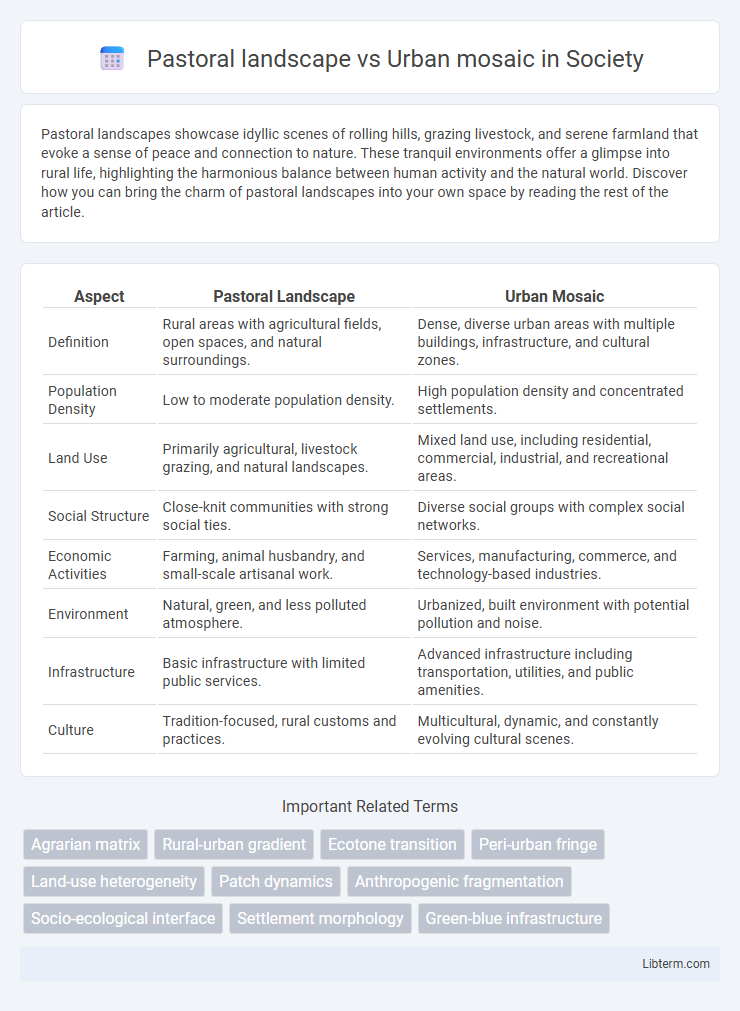Pastoral landscapes showcase idyllic scenes of rolling hills, grazing livestock, and serene farmland that evoke a sense of peace and connection to nature. These tranquil environments offer a glimpse into rural life, highlighting the harmonious balance between human activity and the natural world. Discover how you can bring the charm of pastoral landscapes into your own space by reading the rest of the article.
Table of Comparison
| Aspect | Pastoral Landscape | Urban Mosaic |
|---|---|---|
| Definition | Rural areas with agricultural fields, open spaces, and natural surroundings. | Dense, diverse urban areas with multiple buildings, infrastructure, and cultural zones. |
| Population Density | Low to moderate population density. | High population density and concentrated settlements. |
| Land Use | Primarily agricultural, livestock grazing, and natural landscapes. | Mixed land use, including residential, commercial, industrial, and recreational areas. |
| Social Structure | Close-knit communities with strong social ties. | Diverse social groups with complex social networks. |
| Economic Activities | Farming, animal husbandry, and small-scale artisanal work. | Services, manufacturing, commerce, and technology-based industries. |
| Environment | Natural, green, and less polluted atmosphere. | Urbanized, built environment with potential pollution and noise. |
| Infrastructure | Basic infrastructure with limited public services. | Advanced infrastructure including transportation, utilities, and public amenities. |
| Culture | Tradition-focused, rural customs and practices. | Multicultural, dynamic, and constantly evolving cultural scenes. |
Defining Pastoral Landscapes and Urban Mosaics
Pastoral landscapes are characterized by expansive, open fields, grazing livestock, and agricultural activities that emphasize harmony between human farming practices and natural ecosystems. Urban mosaics consist of diverse, densely built environments combining residential, commercial, and public spaces, reflecting complex social, economic, and infrastructural networks. Defining pastoral landscapes involves identifying patterns of land use focused on cultivation and animal husbandry, while urban mosaics are defined by heterogeneous land use patterns and high spatial fragmentation driven by urbanization.
Historical Evolution of Rural and Urban Spaces
Pastoral landscapes have historically evolved from agrarian societies emphasizing extensive farming and natural scenery, reflecting rural traditions and slower-paced lifestyles. Urban mosaics emerged with industrialization, characterized by densely packed structures, diverse architectural styles, and vibrant cultural interconnectivity shaped by rapid population growth and technological advancements. The transition from pastoral to urban spaces illustrates socio-economic shifts, land use changes, and evolving human-environment relationships over centuries.
Key Elements of Pastoral Landscapes
Pastoral landscapes are characterized by expansive fields, grazing livestock, and natural water bodies that support agricultural activities and biodiversity. Key elements include rolling hills, meadows with grasses, hedgerows, and farmsteads that contribute to a serene and productive rural environment. These features contrast with the fragmented and densely built structures typical of urban mosaics, highlighting the pastoral landscape's emphasis on harmony with nature and land use for agriculture.
Characteristic Features of Urban Mosaics
Urban mosaics exhibit heterogeneous land use patterns characterized by dense, irregularly arranged buildings, contrasting sharply with the uniformity of pastoral landscapes. These areas feature diverse architectural styles, compact infrastructure, and multiple transportation networks that facilitate complex social and economic interactions. High impervious surface coverage and fragmented green spaces further define the dynamic, multifunctional nature of urban mosaics.
Land Use Patterns: Contrasts and Comparisons
Pastoral landscapes typically exhibit extensive land use patterns characterized by large, contiguous areas of agricultural fields and grazing lands, supporting livestock and crop cultivation with minimal structural fragmentation. In contrast, urban mosaics demonstrate highly fragmented land use patterns with dense clusters of residential, commercial, and industrial zones interspersed with transportation networks and green spaces. These contrasting spatial arrangements highlight the shift from predominantly natural and agricultural land utilization in pastoral settings to diversified, multifunctional land use in urban environments.
Ecological Impacts: Biodiversity and Habitat
Pastoral landscapes support moderate biodiversity through open grasslands and scattered trees, providing habitats for grazing species and ground-nesting birds, but tend to have lower species richness compared to natural ecosystems. Urban mosaics create fragmented habitats with high edge effects, often reducing native biodiversity but sometimes increasing species richness by supporting generalist and invasive species adapted to anthropogenic environments. Habitat fragmentation in urban areas disrupts wildlife corridors and ecological connectivity, whereas pastoral lands maintain larger contiguous habitats critical for sustaining specialized flora and fauna.
Human Activities and Cultural Influences
Pastoral landscapes are characterized by agricultural activities such as farming and livestock grazing, reflecting traditional rural lifestyles and deep-rooted cultural practices tied to land stewardship. In contrast, urban mosaics feature diverse human activities including commerce, industry, and varied residential patterns, demonstrating cultural influences shaped by migration, innovation, and economic development. Both landscapes reveal unique human-environment interactions, where cultural heritage and social dynamics influence land use and spatial organization.
Visual Aesthetics and Spatial Organization
Pastoral landscapes feature expansive green fields, natural elements, and organic spatial organization emphasizing tranquility and open views, creating harmonious visual aesthetics with soft, flowing lines and muted colors. Urban mosaics consist of dense, heterogeneous blocks with varied architectural styles, sharp edges, and vibrant color contrasts, reflecting dynamic spatial organization and visual complexity. The juxtaposition highlights pastoral landscapes' emphasis on natural beauty and continuity against urban mosaics' structured diversity and visual intensity.
Socio-economic Dynamics in Both Environments
Pastoral landscapes exhibit socio-economic dynamics rooted in agriculture, livestock farming, and rural livelihoods that foster close-knit communities reliant on natural resource management. Urban mosaics present complex socio-economic interactions driven by diverse industries, dense populations, and multifaceted labor markets, leading to economic specialization and social stratification. The contrast between these environments highlights disparities in income distribution, access to services, and economic opportunities shaped by spatial organization and infrastructure development.
Future Trends: Blurring the Rural-Urban Divide
The pastoral landscape is undergoing transformation as urban mosaic elements increasingly integrate into rural settings, driven by advances in smart infrastructure and sustainable agriculture technologies. Future trends highlight the emergence of hybrid zones where digital connectivity and green spaces coexist, fostering economic diversification and lifestyle changes that blur traditional rural-urban boundaries. This convergence promotes innovative land use patterns and community resilience, reshaping demographic dynamics and environmental management strategies.
Pastoral landscape Infographic

 libterm.com
libterm.com